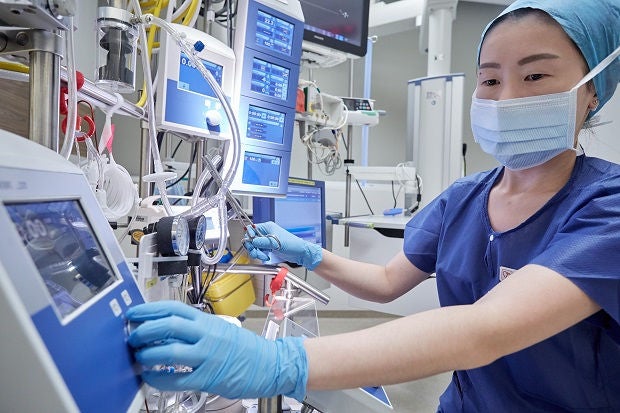
Patients with advanced heart failure, whose condition cannot be treated by conventional medical or surgical interventions, require a heart transplant. At the National Heart Centre Singapore, they are cared for by a multidisciplinary team whose expertise gives patients holistic care and rehabilitation.
Tan Yee Jean, Senior Perfusionist
During a heart transplant surgery, patients are placed on cardiopulmonary bypass with a heart-lung machine. Perfusionists like Yee Jean operate the heart-lung machine and maintain the haemodynamic status (flow of blood) of the patient throughout the entire period of the bypass.
"Besides operating the heart-lung machine, I also tend to other cardiac devices, such as the intra-aortic balloon pump, which aids in the cardiac output of the transplant patient just before or after the cessation of bypass; the cell saver, which salvages the patient’s own whole blood; and extracorporeal membrane oxygenation to provide cardio and respiratory support in situations where the patient cannot be weaned off from cardiopulmonary bypass."
Jael Tay, Principal Clinical Coordinator

Jael assesses each patient’s suitability for a heart transplant and coordinates the procedures leading up to and after the surgery.
"I am the main point of contact for heart transplant patients, and I continue to stay in touch with them even after their surgeries. Besides assisting them in their routine evaluations, I follow up on their medication and keep close tabs on their daily activities. It is important to ensure that patients are scheduled for all necessary appointments and are making good progress in their recovery."
Loh Peh Rong, Cardiac Technologist

As a cardiac technologist, Peh Rong assists cardiologists in diagnosing and treating heart-related ailments.
"Before and after each surgery, I carry out tests such as echocardiographic assessments and procedures such as cardiac biopsies to monitor the condition of heart disease patients. I also review patient documentation, schedule appointments and monitor patients’ heart rates."
Chen Hebin, Principal Physiotherapist

After a heart transplant, patients are sent to the Cardiothoracic Intensive Care Unit (CTICU) for recovery. At the CTICU, Hebin assists patients with breathing exercises and simple movements to improve muscle function in their limbs. Sitting and walking exercises also commence early in the CTICU to improve the patients’ physical function.
"Carefully prescribed exercise helps patients in their recovery. Prior to their discharge, we give tips on how they can continue to exercise safely and take good care of themselves at home. This will prepare patients for outpatient physiotherapy, where they can focus on further improving their exercise tolerance and physical function."
Pindar Yu, Senior Principal Dietitian, Singapore General Hospital

Pindar offers heart transplant patients personalised dietary advice, evaluates their nutritional status, and works with them on their nutritional goals.
"I usually advise patients on nutrition balance and food safety, such as avoiding pre-cut fruits sold at fruit stalls, half-boiled or raw eggs, and raw seafood, as these foods are potential sources of pathogens that can cause infection. After undergoing a transplant, patients may feel an improvement in their general well-being and quality of life. However, I always remind them not to overeat as this may put excessive stress on the new heart."
This story was published in the Singapore Health Special Allied Health Professionals Issue 2021.













 Get it on Google Play
Get it on Google Play